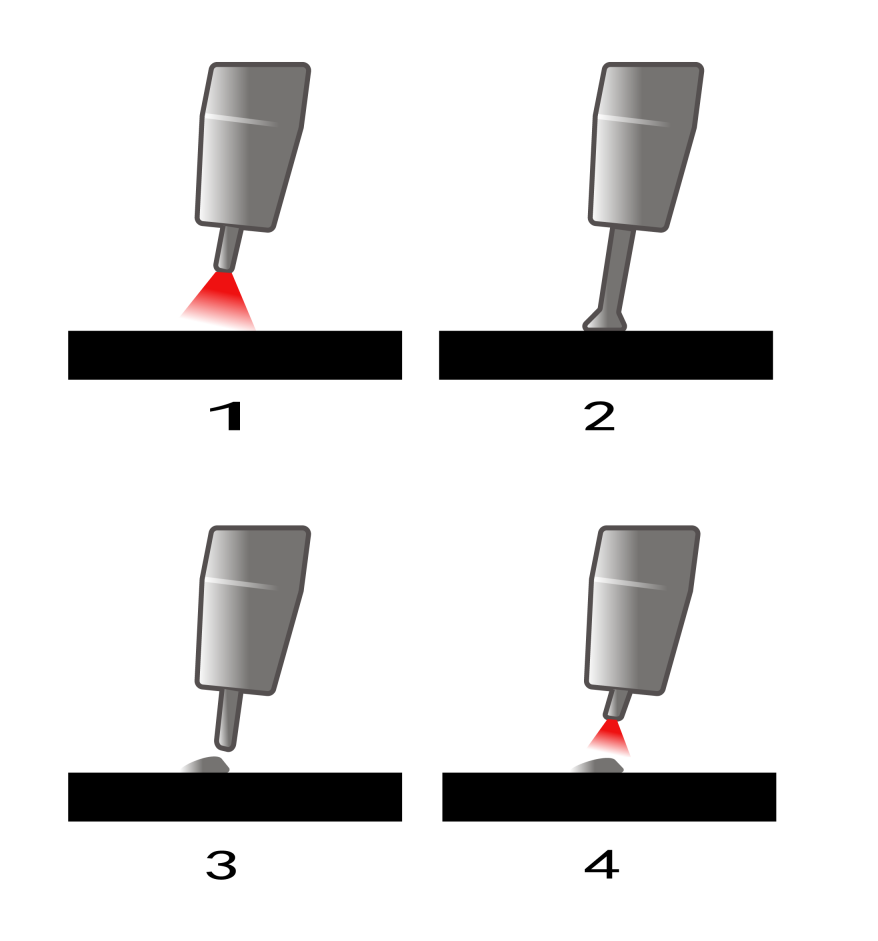La transferencia de metal en frío (CMT) es una técnica de soldadura que resuelve eficazmente el problema habitual de las salpicaduras de escoria. Este método reduce significativamente el aporte de calor durante el proceso de soldadura mediante un mecanismo de transferencia de arco controlado, lo que lo hace especialmente beneficioso para aplicaciones en las que la soldadura MIG/MAG tradicional tiene dificultades, como la soldadura de chapas finas o la combinación de materiales disímiles como el acero y el aluminio. La evolución del proceso GMAW, CMT incorpora una técnica para lograr la transferencia de metal con una intensidad de calor mínima, creando una secuencia caliente-fría que reduce la presión del arco y el aporte térmico, mejorando la productividad y reduciendo la necesidad de acabado posterior a la soldadura. (Marulanda, 2008).

CMT son las siglas de Cold Metal Transition Technology, una versión mejorada de la transferencia en cortocircuito. Combina las acciones de alimentación y retracción del hilo de una forma que no lo hace el GMAW tradicional. El proceso comienza con el encendido del arco y el avance del hilo, formando una gota fundida que, mediante un cortocircuito, hace que el hilo se retraiga y la gota se desprenda, reduciendo significativamente la corriente y la tensión. Esta acción dinámica, que se produce hasta 70 veces por segundo, hace que el CMT sea único y eficaz en las aplicaciones de soldadura. La innovación de añadir pulsos (CMT + P) refina aún más este proceso, combinando los modos de transferencia proyectada y en cortocircuito para conseguir procesos de transferencia estables y suaves, permitiendo una mayor penetración y ángulos de contacto del cordón de soldadura con corrientes de pulsos más elevadas. (Pang et al., 2016).

El CMT mejora la precisión de la soldadura y la velocidad operativa gracias a la rápida oscilación del hilo, lo que garantiza una zona de soldadura limpia con un mínimo de salpicaduras y un menor aporte de calor. Esto reduce la deformación del material y el impacto circundante, al tiempo que mantiene una calidad de arco estable. Su versatilidad en varias velocidades de soldadura y su destreza en la soldadura de materiales finos o en el puenteado de huecos pone de manifiesto su adaptabilidad e innovación. La capacidad de CMT para revolucionar la soldadura de metales distintos y materiales más gruesos lo ha convertido en el método preferido en los sectores de automoción, defensa y energía, mejorando la estética de la soldadura y reduciendo el aporte de calor. (Selvi, Vishvaksenan, & Rajasekar, 2017).
CMT ha revolucionado la soldadura de metales distintos y materiales más gruesos, mejorando la estética del cordón de soldadura y reduciendo el aporte de calor. La soldadura CMT se utiliza ampliamente en los sectores de automoción, defensa y energía, y se prefiere a los métodos de soldadura tradicionales para combinaciones de aluminio y acero. (Selvi, Vishvaksenan, & Rajasekar, 2017).
Precisión y eficacia: La rápida oscilación del hilo aumenta la precisión y la velocidad de soldadura.
Área de soldadura limpia: La meticulosa transferencia de gotas de CMT garantiza una zona de soldadura limpia con salpicaduras mínimas.
Entrada de calor reducida: Esta técnica reduce eficazmente la entrada de calor, mitigando la deformación del material y el impacto circundante.
Arco Estable: El proceso se ajusta dinámicamente para mantener la estabilidad del arco, garantizando una calidad de soldadura constante.
Aplicación versátil: La CMT se adapta a varias velocidades de soldadura, por lo que es adecuada para una amplia gama de aplicaciones.
Ideal para soldaduras complejas: Su destreza en la soldadura de materiales finos o en el puenteado de huecos pone de manifiesto su versatilidad.
Aunque la CMT ofrece numerosas ventajas, requiere operarios cualificados y equipos más caros, y sus beneficios pueden no aplicarse universalmente a todos los materiales o a las piezas más gruesas.
CMT se distingue de la soldadura MIG/MAG por ofrecer arranques más rápidos, menos salpicaduras, mayor velocidad de soldadura y menor aporte de calor, lo que minimiza la distorsión. También permite un control más preciso de la longitud del arco y mantiene un arco más estable, lo que hace posible soldar placas de aluminio extremadamente finas de hasta 0,3 mm, ofreciendo así una mayor flexibilidad de montaje.
La mínima aportación de calor de CMT la hace superior para soldar aluminio delgado, superando las limitaciones de la soldadura MIG/MAG. La incorporación de la tecnología CMT automatizada de XD Thermal ejemplifica su eficacia a la hora de agilizar el proceso de soldadura, mejorar el posicionamiento y soldar piezas con una configuración mínima, lo que aumenta la eficiencia.

A medida que la tecnología de soldadura evoluciona y se inclina hacia soluciones a mayor escala y más inteligentes, se espera que la integración de diversas técnicas, la integración de diversas técnicas mejore significativamente la calidad de la soldadura. Aprovechando los puntos fuertes de los distintos métodos, incluida la CMT, las prácticas de soldadura se harán más sofisticadas. La CMT, con su sofisticado enfoque, está preparada para liderar la innovación en soldadura, satisfaciendo la demanda de soluciones de soldadura a mayor escala y más inteligentes.
Utilizando la técnica de soldadura Cold Metal Transfer (CMT), XD THERMAL ha desarrollado una placa de refrigeración líquida que subraya la capacidad del método para producir soldaduras duraderas y de alta calidad para una disipación eficaz del calor, ofreciendo así una gestión térmica superior para los sistemas de baterías. Esta innovación no sólo ejemplifica la dedicación de XD THERMAL a la tecnología punta y mejora la eficacia y seguridad de las soluciones de gestión térmica de baterías, sino que también proporciona un rendimiento térmico y una fiabilidad superiores, poniendo de relieve la capacidad de la empresa para gestionar eficazmente cargas térmicas elevadas.